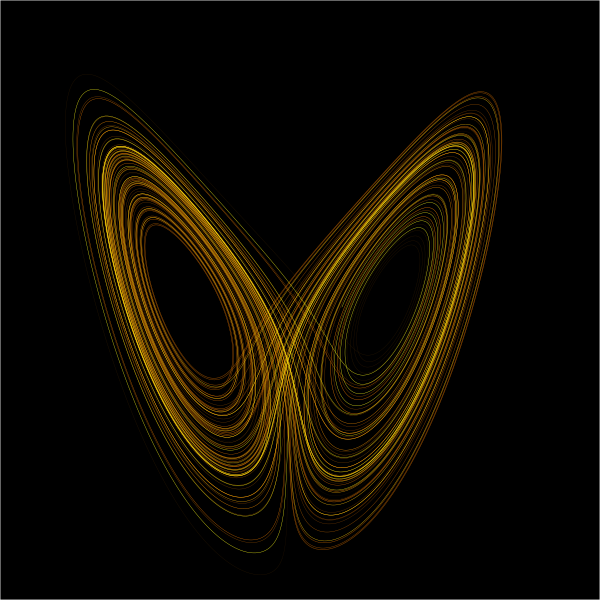Chaos: The orderly secrets of our disorderly world
Perspective
Sayantan Khan

John Updike once mentioned, "Human was the music, natural was the static". This article focuses on the beauty of chaos theory, most of which is still a mess of gorgeous mysteries. Chaos and order are exhaustive. In all chaos, there is a cosmos, and in all disorder, a secret order.
Tweet
“Ordnung braucht nur der Dumme, das Genie beherrscht das Chaos (Everybody can handle order, but only a genius can master chaos)”
~Albert Einstein
Surely, Dr. Harvey J. Gold was not joking when he stated that the result of a mathematical development should be continuously verified against one’s own intuition about what constitutes reasonable biological behavior. When the results are in then the following possibilities must be considered. Firstly, there might be a serious error in the formal mathematical development. Also, it could be that the starting assumptions are incorrect and/or constitute a drastic oversimplification. It may refer to inadequate development of one’s own intuition about the biological field. Lastly, it could also be concluded that a new principle has been discovered.
The concept of ‘chaos’ and ‘order’ is actually more complementary than the contrary. The ‘butterfly effect’ is an excellent checkpoint over this argument. However, there are a plethora of people who question its validity. But this confusion absolutely dies away when the ball is in the court of experts. Now the question arises, is it real? Yes.
The Butterfly effect conceptualizes that small changes at small scales can bring about large-scale changes elsewhere, asserting that the flap of a butterfly’s wing in New York could possibly bring about a storm in Tokyo. Although it is quite unlikely that one butterfly could affect any kind of meaningful change in the weather, the theory brings to light the multiple factors and delicate balances on which our entire reality depends.
Butterflies are too small to cause any real change. But larger objects, let’s say an airplane, say, or a cumulus cloud can have an eventual effect on the weather everywhere. Presence or absence of a cloud can change circulations around the cloud, which, as they change, will change the even larger circulations in the atmosphere, which then change still-larger circulations, and so you get this cascade of influential upscaling.
A more intriguing phenomenon is the ‘quantum butterfly effect’. It arises in systems combining chaos with the weird physics of the quantum world. For these kinds of systems, there are notions of quantum chaos, but precise identification of the quantum butterfly effect is an area of ongoing research. In some cases, we can identify an experimentally detectable property that is expected to repeatedly double as in the classical butterfly effect. But we don’t know whether it’s possible to make sense of this yet for general quantum chaotic systems. To be more coherent, let’s imagine an experiment with a time machine. You go far back in time and change one tiny inconsequential thing, like the position of a single atom. Then, when you zoom forward to the present again, almost everything will have changed considerably, in a random manner.
Most people like to have a sense of order and predictability in their lives. They like to plan for the future and know that there is a reasonable probability of seeing their dreams fulfilled. However, the natural world around us, in spite of its outward beauty and longevity, seems to defy all efforts at predicting its future. In this context, understanding chaos would undoubtedly be of great benefit. It’s not too important to be able to understand and control the chaos in a pinball machine, but how about understanding chaos in the atmosphere, or chaos in the human brain and heart? The answer is a resounding yes. It has been argued that some cardiac arrhythmias are instances of chaos. This opens the doors to new strategies of control.
 Simple systems behave in simple ways. A mechanical contraption like a pendulum, a small electrical circuit or a population of fish where all individuals have an equal opportunity to pass on their genes, as long as these systems could be reduced to a few well-understood, deterministic laws, their long-term behavior would be stable and predictable. Whereas, complex behavior implies complex causes. A mechanical device, a biological organ, a wildlife population, a particle beam, an atmospheric storm, a national economy, a system that was visibly unstable, unpredictable, or out of control must either be governed by a multitude of independent components or subject to random external influences.
Simple systems behave in simple ways. A mechanical contraption like a pendulum, a small electrical circuit or a population of fish where all individuals have an equal opportunity to pass on their genes, as long as these systems could be reduced to a few well-understood, deterministic laws, their long-term behavior would be stable and predictable. Whereas, complex behavior implies complex causes. A mechanical device, a biological organ, a wildlife population, a particle beam, an atmospheric storm, a national economy, a system that was visibly unstable, unpredictable, or out of control must either be governed by a multitude of independent components or subject to random external influences.
Earlier, researchers described chaos as the century’s 3rd revolution in physics, after relativity and quantum mechanics. Let’s take another example. White daisies reflect light, making the planet cooler. Black daisies absorb light, lowering the reflected solar radiation, thus making the planet warmer. But white daisies thrive in warmer climates, while, black daisies thrive in cold climates. These attributes can be expressed in a set of differential equations and they might be used to run simulated models to understand how the daisy world might look like. It is expected that it won’t be a perfect equilibrium, but there might be small equilibrium-like conditions co-existing.
It’s high time to dig deep into the laws of thermodynamics. As everything tends towards disorder, any process that converts energy from one form to another must lose some energy as heat. Perfect efficiency is impossible. The universe is a one-way street. Entropy must always increase in the universe and in any hypothetical isolated system within it. In our world, complexity flourishes, and those looking to science for a general understanding of nature’s habits will be better served by the laws of chaos.
We have visualized a very deep order concerning chaos, but, to put it simply, it all sounds quite ‘chaotic’. To conclude, there exists so much ‘chaos’ worldwide and the amount of interest and active research it attracts, it can only be expected that advancements will continue at a rapid pace in this mesmerizing field of ‘chaos theory’, hopefully to the benefit of all mankind.
References
Sayantan is a 2nd Year BS-MS undergrad, a KVPY Fellow, and a budding Chem enthusiast, currently pursuing his studies in IISER Kolkata. Apart from being professionally passionate, he loves writing poems, reading storybooks, playing chess & cricket, or jamming with guitar in his leisure. He enjoys photography, blogging, and exploring everything from quarks to quasars. He is an aspiring researcher in the field of chemical sciences and believes in the life philosophy - ‘Do good, be good’.
signup with your email to get the latest articles instantly